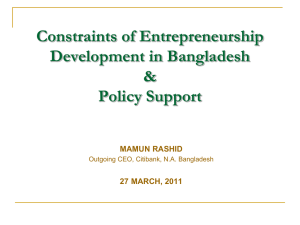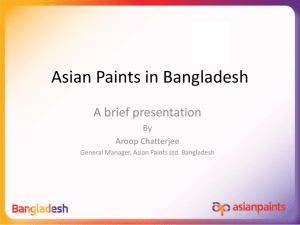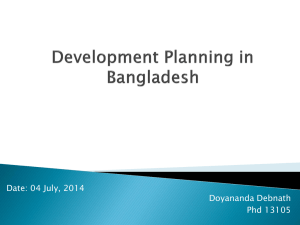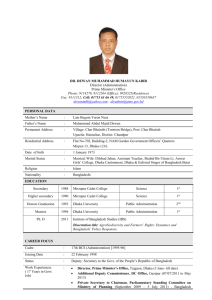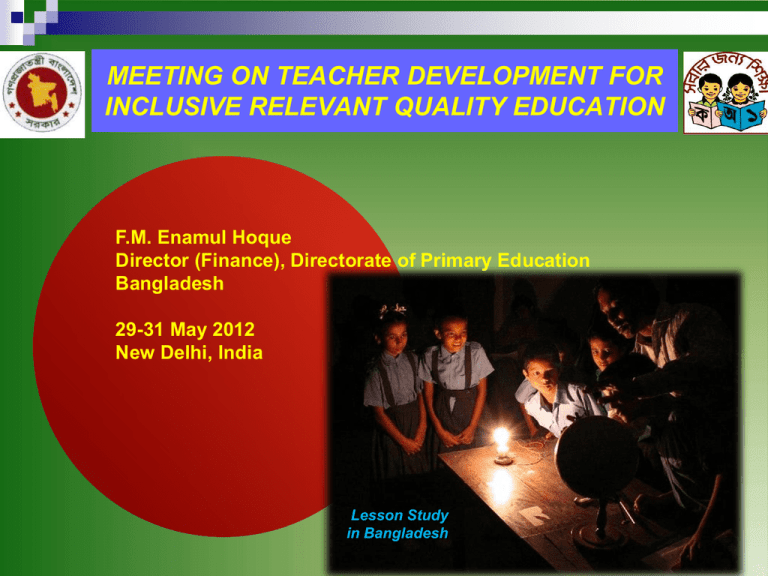
MEETING ON TEACHER DEVELOPMENT FOR
INCLUSIVE RELEVANT QUALITY EDUCATION
F.M. Enamul Hoque
Director (Finance), Directorate of Primary Education
Bangladesh
29-31 May 2012
New Delhi, India
Lesson Study
in Bangladesh
Country Background
Bangladesh is situated to the eastern side of the Indian Subcontinent,
flanked by India in the West, North and Northeast and Myanmar to the
Southeast
Bangladesh is a tropical country and threaded by rivers, the three
great rivers, Padma, Jamuna and Meghna
The highest density of population in the world having a sustained
economic progress with more than 6% growth for last three years.
Government of Bangladesh attaches strong importance and priority
for achieving the goals of EFA through implementing free and
compulsory primary education especially ensuring quality and inclusive
education and maintaining gender parity
ORGANIZATIONAL STRUCTURE OF
PRIMARY EDUCATION IN BANGLADESH
Ministry of Primary and Mass Education
(MOPME)
Directorate of Primary Education
(DPE)
National Academy for Primary
Education (NAPE)
Divisional Deputy Director Office
District Primary Education Office
Upazila Education Office
Primary Training Institute (PTI)
Upazila Resource Centre (URC)
SCHOOL
Constitutional Rights
Education is the fundamental right of citizens of Bangladesh. The
Constitution of the People’s Republic of Bangladesh has preserved
rights for education with more focus on women development
Article 15 (a) of the
constitution of the People’s
Republic
of
Bangladesh
attaches the same importance
to education as other rights like
food, shelter, clothing and
health care.
Article 17 of the constitution also
provides (a) establishing a
uniform,
mass-oriented
and
universal system of education and
extending free and compulsory
primary education to removing
illiteracy from the country.
Education Policy 2010
Education policy 2010 gives much emphasis on
primary education and adds separate chapters to
express the philosophy of the nation about primary
education.
Primary Education in Bangladesh
Types
Government Primary
Registered Non-Government Primary
Numbers
37672
20061
Non-registered Primary
666
Community
3169
Kindergarten
4418
NGO
361
Ebtedaee Madrasa
2305
Attached to High Madrasa
9120
Attached to High School
858
Total
78685
Inclusive Education in
Bangladesh
Achieve Universal Primary Education.
According to Census 2010 conducted by Directorate of Primary
Education, the enrolment rate is 99.1% in Bangladesh.
Promote Gender Equality and Empowerment of Women
Bangladesh is committed to meet the Education For All (EFA) goals
that all children have access to a completely free and compulsory
primary education of good quality.
National Plan of Action (NPA) 2002 – 2015.
The Bangladesh Primary Education (Compulsory) Act 1990
The E-9 Declaration (2000)
Second Primary Education
Development Program
(PEDP-II)
It covers 4 main components
Component 1
Quality
improvement
through
organisational
development
and
capacity building
Component 2
Quality
improvement in
schools and
classrooms
Component 3
Component 4
Quality
improvement
through
infrastructure
development
Improving and
supporting equitable
access to quality
schooling
Inclusive Education Framework
Detailed strategy and action plans have been developed
separately specifically to cover Gender and Children with
Special Needs.
Strategy and action plans have been prepared to
Mainstreaming Ethnic Minority Children’s Education and to
Mainstreaming Education for Vulnerable Groups.
Strategies and Action Plan to Mainstream
Special Needs Children
The key areas need to be addressed
Improved accessibility and ensuring seating for disabled children
Awareness-raising at all levels in the system and within communities
Teacher training and support for teachers at school level to bring about
changes in
teaching methodology
Increased teacher awareness of their responsibility to provide for all children
Improved identification and assessment of children’s difficulties
Flexibility in curriculum and school assessment
Children with mentally retarded
Children with physically impaired
Children with hearing impaired
Children with communicational impaired
Children with visually ampere
Enrolment State
Enrolment in 2012
Grade
Normal
In ‘000
Special Needs
In ‘000
Overall
In ‘000
Boys
Girls
Total
Boys
Girls
Total
Grand
Total
I
2355
2308
4663
11
9
20
4683
II
2273
2216
4489
12
10
22
4511
III
2173
2150
4323
12
10
22
4345
IV
1899
1912
3811
10
9
19
3830
V
1643
1671
3314
8
6
14
3328
Total
20697
TRAINING IMPARTED
Participants
Teacher
PTI
ADPEO
UEO
AUEO
Total
Number
62000
110
120
500
2650
65380
PLAN TO IMPART TRAINING
Participants
C-in-ED
Number
16028
Sub-Cluster
Need-based
11496
10000
Orientation for New Teacher
Dip-in-ED
Leadership (Head Teacher)
10000
1400
100
ICT Education in Model School
Total
5000
43024
Gender Strategy and Action Plan
Document was approved by MoPME in January 2006
Increased numbers of female teachers
Greater gender balance in all recruitment
Building gender awareness and sensitivity throughout the system
Strategy and Action Plan for
Mainstreaming Vulnerable Children’s
Education
This document considers vulnerability
It identifies the following specific groups as being vulnerable: street
children, children from the very poor families, working children, child
sex workers and children of the sex workers, children from refugee and
Biharis (Non- Bengali) communities, children from disaster prone,
remote/ river island/char, haor and coastal areas, children living in
urban slums, children of special occupation groups and communities
(gypsy, sweeper, cobbler etc.), children with HIV/AIDS, trafficked
children, orphaned children, children from the tea gardens, children
from the fishing community, imprisoned children
Action Plan for Mainstreaming Ethnic
Minority Children’s Education
Main recommendations are:
Recruit community based teachers
Organize training and orientation courses for teachers.
Introduce pre-primary schooling using mother tongue languages
Review curriculum and textbooks
Improve infrastructure of the schools
Strengthen the supervision and monitoring
Strengthen the SMC
Establish new primary schools
Emphasis on autism in PEDP-III
DPE & UNICEF jointly will organize a consultative/idea-sharing workshop with
autism experts in Bangladesh.
It is decided that a Meena Cartoon would be developed from the ideas of the
sharing workshop.
The developed Meena Cartoon will be used for growing awareness about
Autism all over the country.
Sub cluster training for quick coverage for the teachers.
One-day orientation for all level officials/teachers.
Ensure screening in the appropriate way at school level.
Easily understandable concept paper on different kind of special needs
children/excluded children/vulnerable/the reason for drop out could be
developed and ensure use.
FUNDING FOR PRIMARY EDUCATION
Share of Education in National Budget is about
16.25%
Allocation for Primary Education is about 41.15% of
total Education Budget
Government has Allocated about 7.7 billion BDT in
this FY 2011-12
For FY 2012-13 Government is planning to Allocate
about 10.0 billion BDT
Key Achievements
6 divisional workshops
64 district workshops
54 PTI trainee teacher’s orientation program on IE
IE, Gender, Special Needs/Disability, Tribal & Vulnerable Brochures
developed (12 brochures) is under procurement process
Calendar on IE developed, printed & distributed (86,000) for year
2008 and 2009
Incorporated IE in SMC training manual (60,000 participants trained
during 2008-09 FY)
Developed sub-cluster training leaflet on IE issues
Incorporated IE in Head teachers’ School Management Training
manual (24,000 participants trained)
Training manual developed for field level officer
Incorporated IE in SMC training manual
National Teachers Training
Training in many ways:
Inclusive Education incorporated as a subject in DPEd
IE training manual developed and training conducted in URCs
IE incorporated in pre-primary curriculum developed by NCTB
Sub cluster training leaflet developed and ongoing in the system
IE leaflet developed and shared with all stakeholders
A number of sharing workshops organized for trainee teachers in PTIs
Challenges
The main challenges are :
Breaking down existing attitudes and values
Developing awareness and understanding at all levels
Providing support for teachers
Providing appropriate teaching and training methods
Providing appropriate teaching materials and teaching aids
Ensuring transfer of training into teaching practice
Ensuring teachers share new knowledge and methodologies
Developing a flexible learner-friendly environment
Governance especially ensuring good governance up to the
grass-roots level
Recommendations
Mass awareness-raising of the importance of education within the
various communities
Provide Early Childhood Education as preparation for formal schooling
Link schools with secondary schools, vocational training and other
institutions or organisations to assist children
Schools to be flexible to respond to the specific difficulties of the local
community, in particular schools timing, contact hours, holidays, students
evaluation system, teachers appointments, transfer, posting
Inter-ministerial coordination and cooperation to improve health,
sanitation, education, security, financial support, and relief in times of
disaster and food crisis
Thank You





